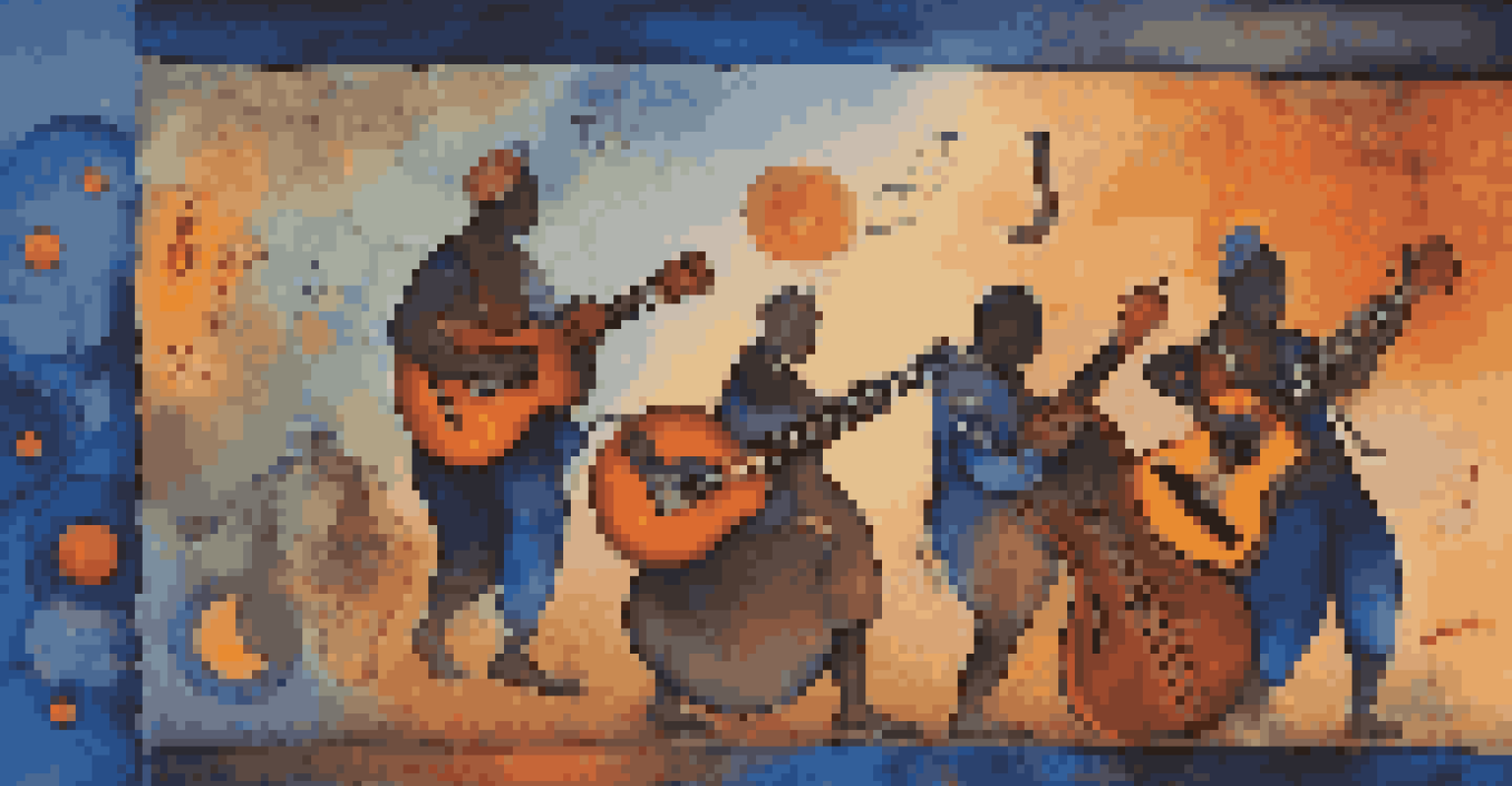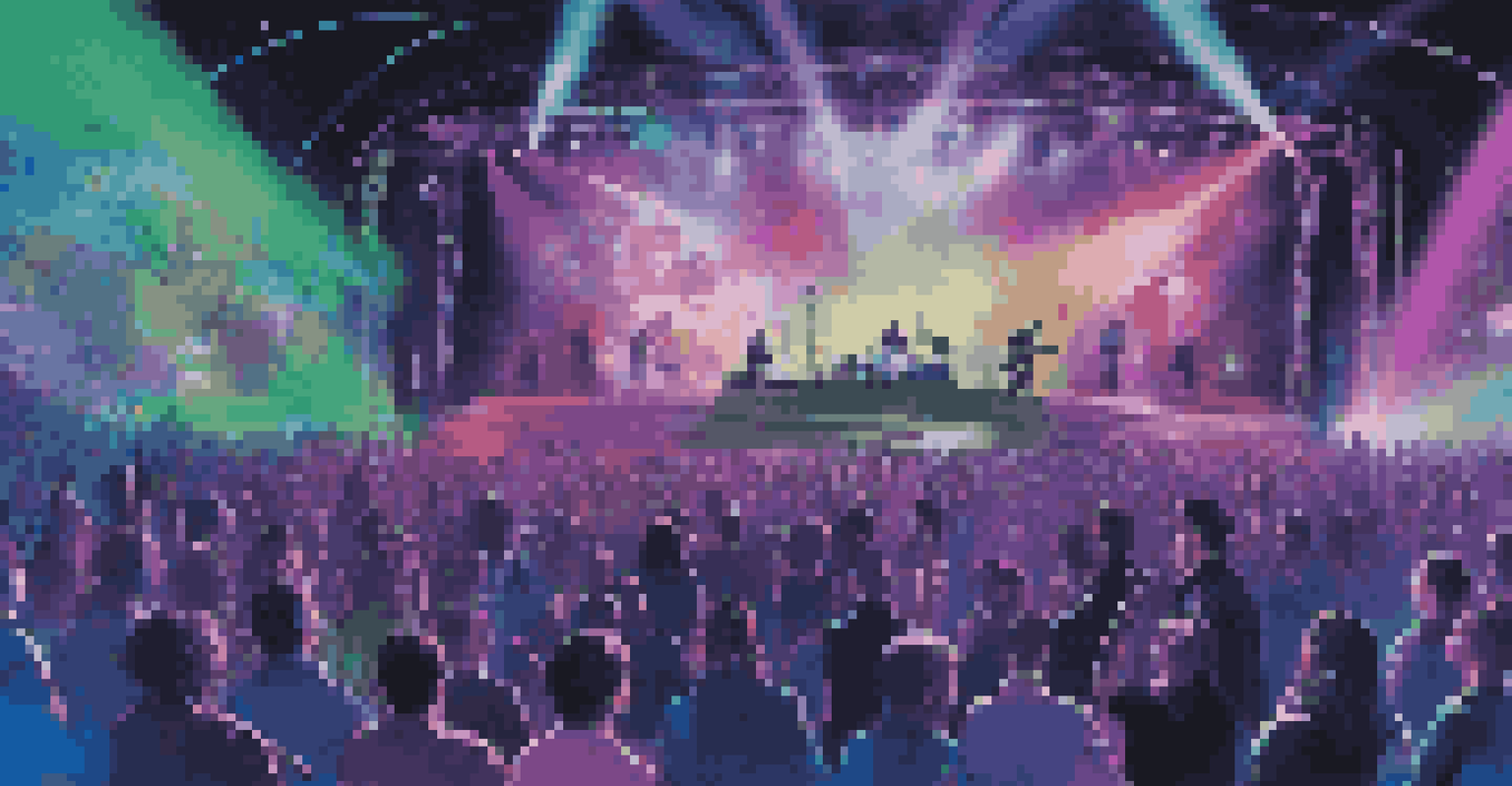The Future of Music Collaborations: Virtual and Global Trends

The Rise of Virtual Music Collaborations
In recent years, technology has transformed how musicians work together. Virtual collaborations allow artists from different corners of the globe to unite, regardless of geographical barriers. This trend has gained momentum, especially during the pandemic, when physical meetups were limited, pushing artists to explore digital platforms.
Music can change the world because it can change people.
Platforms like Soundtrap and Splice have become popular tools, enabling musicians to create and share music in real time. These tools foster creativity, allowing artists to collaborate seamlessly from their own homes. Imagine a singer in New York working harmoniously with a producer in Tokyo, all through the power of the internet.
As we look to the future, these virtual collaborations are likely to become even more common. With advancements in technology, the possibilities for creating music together from afar are endless, making it an exciting time for artists everywhere.
Global Connectivity: Breaking Down Borders
Global connectivity has revolutionized the music industry, enabling artists to reach wider audiences. This interconnectedness allows for cross-cultural collaborations that blend diverse musical styles, creating unique and innovative sounds. For example, a collaboration between a hip-hop artist from Los Angeles and a traditional sitar player from India can yield a fresh fusion of genres.

Social media platforms and streaming services facilitate these connections, making it easier for artists to discover one another. As they share their work, they not only gain followers but also inspire each other to experiment with their sound. This cultural exchange enriches the music landscape and encourages creativity.
Virtual Collaborations Transform Music
Musicians can now collaborate seamlessly from anywhere in the world, thanks to advancements in digital platforms and technology.
As artists continue to embrace global connectivity, we can expect to see an exciting array of new genres emerging. The music of tomorrow may sound different, but it will undoubtedly reflect the rich tapestry of human experiences across the globe.
The Role of Technology in Music Creation
Technology plays a pivotal role in shaping the future of music collaborations. From sophisticated recording software to AI-driven tools, musicians now have access to an array of resources that enhance their creative process. For instance, AI can assist in generating melodies or even suggesting chord progressions, making it easier for artists to bring their visions to life.
The beautiful thing about music is that it transcends language.
Moreover, virtual reality (VR) is opening new avenues for collaborative experiences. Imagine donning a VR headset and jamming with musicians from around the world as if you were in the same room. This immersive experience can create a sense of presence that traditional online collaborations may lack.
As technology continues to evolve, it will undoubtedly influence how musicians create and collaborate. The integration of these tools not only streamlines the process but also inspires innovation, leading to exciting new music that pushes boundaries.
Collaborative Platforms: A New Era of Music Sharing
Collaborative platforms are at the forefront of this music revolution, allowing artists to share their work like never before. Websites like BandLab and Kompoz provide spaces for musicians to connect, collaborate, and co-create. These platforms are democratizing the music-making process, enabling anyone with a passion for music to participate.
With these tools, artists can upload their tracks, invite others to contribute, and refine their work collectively. This sense of community fosters an environment where creativity thrives, and musicians feel empowered to explore new ideas. It's akin to a digital jam session where everyone is welcome.
Global Connectivity Enriches Sound
The interconnectedness of artists worldwide fosters cross-cultural collaborations, resulting in unique and innovative musical fusions.
As more artists embrace these collaborative platforms, we can expect to witness an explosion of creativity in the music scene. This shift will not only enhance the quality of music but also encourage more diverse voices to share their stories through their art.
Cultural Influences in Global Collaborations
Cultural influences play a crucial role in shaping music collaborations. When artists from different backgrounds come together, they bring their unique traditions, styles, and stories to the table. This fusion often leads to innovative soundscapes that resonate with a broader audience.
For example, the combination of African rhythms with Western pop elements has given rise to genres like Afrobeats, which have gained international acclaim. These collaborations not only create new musical experiences but also promote cultural appreciation and understanding among listeners.
As the music industry continues to evolve, we can anticipate even more cultural exchanges through global collaborations. This trend will enrich the music landscape and foster connections that transcend borders, ultimately celebrating the diversity of human expression.
The Impact of Social Media on Music Collaboration
Social media has transformed how musicians connect and collaborate. Platforms like Instagram, TikTok, and Twitter enable artists to share their work, engage with fans, and discover potential collaborators. This instant access to a global audience has made it easier for artists to build relationships and find like-minded individuals to work with.
Moreover, viral trends on social media can inspire collaborations and spark new creative ideas. For instance, a popular dance challenge may lead to an artist seeking a producer to create a track that complements the trend. These organic connections often result in exciting collaborations that capture the public's attention.
Social Media Fuels Creative Partnerships
Platforms like Instagram and TikTok have redefined how artists connect, making it easier to find collaborators and engage with global audiences.
As social media continues to evolve, its role in music collaboration will only grow. The ability to connect with others instantly opens up a world of opportunities for artists, paving the way for innovative and engaging music.
Future Trends: What to Expect in Music Collaborations
Looking ahead, several trends are set to shape the future of music collaborations. One major trend is the increasing use of artificial intelligence in the creative process. AI tools can help musicians brainstorm ideas, generate samples, and even assist in mixing tracks, making the collaboration process more efficient and innovative.
Another trend is the rise of virtual concerts and events, where artists can collaborate and perform for a global audience in real time. This shift not only offers new revenue streams for musicians but also allows fans to experience live music from the comfort of their homes. Imagine attending a concert featuring artists from multiple countries, all performing together online.

As these trends continue to develop, the landscape of music collaborations will undoubtedly evolve. By embracing technology and exploring new creative avenues, musicians can forge connections that transcend boundaries and create memorable experiences for fans around the world.